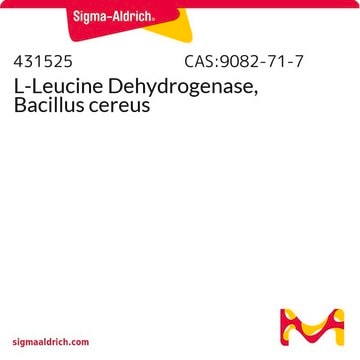推薦產品
一般說明
L-Leucine Dehydrogenase is a member of the amino acid dehydrogenase family.[1]
應用
L-Leucine Dehydrogenase from Bacillus cereus has been used to determine the branched-chain amino acids (BCAA) spectrophotometrically in serum samples.[2]
生化/生理作用
Leucine Dehydrogenase is a nicotinamide adenine dinucleotide hydrogen (NADH)-dependent oxidoreductase. It is involved in catalyzing the reductive amination of aliphatic 2-oxo-acids to their respective L-amino acids.[3]
單位定義
One unit will convert 1.0 μmole of L‑leucine to α-ketoisocaproate per min at pH 10.5 at 37 °C.
其他說明
contains lysine
儲存類別代碼
11 - Combustible Solids
水污染物質分類(WGK)
WGK 3
閃點(°F)
Not applicable
閃點(°C)
Not applicable
個人防護裝備
Eyeshields, Gloves, type N95 (US)
Junping Zhou et al.
Biotechnology journal, 14(3), e1800253-e1800253 (2018-07-28)
Unnatural amino acids (UAAs) play a key role in modern medicinal chemistry such as small molecules and peptide-based drugs with fast-growing markets. Low efficiency for natural enzymes including leucine dehydrogenase (LeuDH, EC1.4.1.9) are one major challenge for UAA production. Here
N Kiba et al.
Journal of chromatography. A, 724(1-2), 355-357 (1996-02-16)
A liquid chromatographic system with a co-immobilized leucine dehydrogenase-NADH oxidase reactor is described for the determination of branched-chain amino acids such as I-leucine, I-isoleucine and I-valine. The enzymes were simultaneously immobilized on tresylate-containing poly(vinyl alcohol) beads. The separation was achieved
T Stoyan et al.
Journal of biotechnology, 54(1), 77-80 (1997-04-04)
The L-leucine dehydrogenase gene from Bacillus cereus (DSM 626) was cloned from a partial genomic library and sequenced. The open reading frame has 1101 bp and codes for a protein of 39.9 kDa. The deduced amino acid sequence of the
T Oikawa et al.
Biochemical and biophysical research communications, 280(4), 1177-1182 (2001-02-13)
X-ray crystallographic studies revealed that various amino acid dehydrogenases fold into two domains in each subunit, a substrate-binding domain and an NAD(P)(+)-binding domain (Baker, P. J., Turnbull, A. P., Sedelnikova, S. E., Stillman, T. J., and Rice, D. W. (1995)
Stéphanie Chevalier et al.
Metabolism: clinical and experimental, 53(3), 388-396 (2004-03-12)
We propose that hyperinsulinemia stimulates protein synthesis when postabsorptive plasma amino acid (AA) concentrations are maintained. During a euglycemic hyperinsulinemic clamp, many AA, notably the branched-chain amino acids (BCAA), decline markedly. Therefore, we tested whether individual plasma AA could be
Active Filters
我們的科學家團隊在所有研究領域都有豐富的經驗,包括生命科學、材料科學、化學合成、色譜、分析等.
聯絡技術服務






